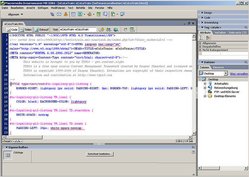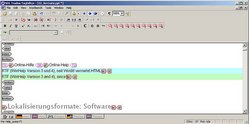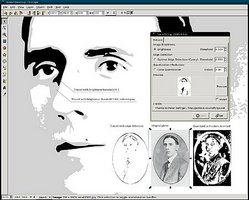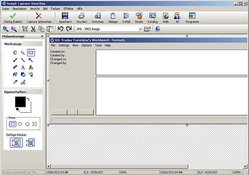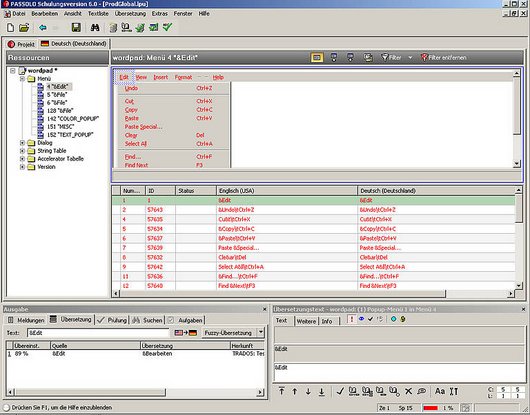
The selection of the tools to be used in a specific localisation project is often made by localisation companies. Localisation companies may have to agree with software development companies on the tools to be used or software development companies may decide to use proprietary tools they have developed. The choice of the tools to be used in a software localisation project usually depends on one or more of the following criteria:
- Client requirements: Should translation memory tools or terminology management tools be used? And if, in which format is the existing translation memory/terminology database available?
- Supported languages: Does the chosen tool support the source and target languages for a specific project and for possible future projects?
- Source file format: Does the chosen tool support the file formats of the project?
- General support: Do the human resources involved in the localisation project need extra training to use the chosen tool? Will this increase costs?
- Costs: How many product licences are available or needed?
- Alignment: If there are translation memories, can any previous translations be aligned using the chosen tool?
- Network environment: Does the chosen tool work in a network environment (e.g. when sharing translation memories, terminology databases, etc.)?
- Customisation: Does the tool offer customisable features (e.g. filters, formats, etc.)?

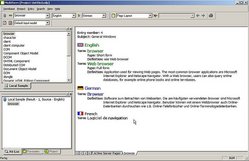
Some examples of the types of tools that can be used in a software localisation project are:
Project management software
These are special tools designed to assist project managers in developing plans, assigning resources to tasks, tracking progress, managing budgets and analysing workloads. These tools can be specially designed for managing translation/localisation projects (dedicated translation project management tools) or for project management in general. For more information on project management and project management tools, please see the Projekt Management Module .
Terminology Management Tools
Terminology Management Tools (TMTs) are software applications which provide a way of defining and manipulating data models, storing data, and allowing controlled access to the data (Trippel, 1999). For more information on terminology management tools, please see the eCoLoTrain Terminology Module .
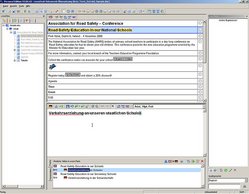

Translation Memory Tools
TM tools allow translators to recycle translation units from previous translation projects (source and target language texts) by automatically proposing a relevant translation from the TM. This proposed translation can be: a) a complete solution – or exact match – whenever an identical source language segment occurs again in the work; or b) a partial solution – also called fuzzy match – whenever a similar source language segment is found in the work. TM tools usually include a set of translation support tools, such as terminology management, word processing, editing, project management and quality control tools. For more information on translation memory tools, please have a look at the eCoLoTrain TM-Modul .
Software Localisation Tools
These tools are specially designed to help translators to localise software user interfaces. Most of these tools offer functionalities such as resource editing, translation memory, leveraging (re-using), validation, spell checking, preview and resizing of graphic user interface elements in software. To know more about these tools, please go to L10N 4 which is entirely devoted to software localisation tools.
Machine Translation Systems
MT systems are software applications which allow computers to translate texts. "Humans may assist in the process through such tasks as pre- or post-editing, but it is the computer, rather than the human, that produces an actual draft translation." (Bowker 2002:147). Depending on the purpose of the translation, for example information purposes, the MT output can be used as such, without post-editing. If the translation is to be published then the output of most MT systems are usually to improve translators' productivity and, as such, require post-editing. When used in the software localisation industry, MT systems get very controlled input which is afterwards edited by translators or localisers and stored in translation memories. One of the most commonly used MT systems is: Comprendium, etc.
Word Counting Tools
These software applications, specially designed for translators, allow counting words, lines or characters. Some examples are Anycount, PractiCount, QuickCount, Textcount and Total Assistant, etc. Some of the advantages of this type of software are: each text is counted in exactly the same way; possible discrepancies regarding formatting are also eliminated since usually several text formats are supported; and normally it is possible to count more than one file at a time. Sometimes, counting tools also enable translators to create invoices and reports – e.g. Total Assistant. Some of these tools can be used to count words in RC and XLIFF files when localising software. To know more about these tools, you can visit the respective websites linked above.
Text Editing Tools
HTML/XML editors: These text editors offer functionalities for the manipulation and previewing of code, typically of programming languages used for web development. Usually HTML or XML editors offer a WYSIWYG functionality (What You See Is What You Get), which is used in computing to preview the final appearance of content during the editing process. These editors also enable users to create pages, so that during the editing process all page and text layout is visible and the markup (text and information on the texts' structure and layout) is not displayed.
Text editors: These are software applications that help to edit plain text. Text editors do not manage document formatting and come with operating systems or software development packages. They can be used to change configuration files and programming language source code. There are several types of text editors. Particularly interesting for the field of software localisation are: source code editors ("text editors with additional functionality to facilitate the production of source code"), and IDEs (or Integrated Development Environment - a type of computer application that aids software development).
These editors are especially useful for project managers, translators and localisers, since sometimes it is necessary to "manually" mark the translatable from the non-translatable strings in a given source code of a software (e.g. when the localisation tool chosen does not offer this functionality or when no localisation tool is used in the project).
Translation memory editors: Tag editors are a new generation of HTML, XML and SGML editors which are integrated in translation memory tools. These editors "protect" the tags (non-translatable elements) in the file and show only "relevant markup" or "translatable text". In this way, translators are able to work directly in the HTML source file without the risk of accidentally modifying the HTML text.
Graphics software
Also called computer graphics or image editing software. These are software applications that enable manipulating images on a computer. Graphics software can be classified in two categories:
Raster graphics
- Raster graphics also digital image or bitmap use collection of dots or pixels to represent images
Vector graphics
- Vector graphics also geometric modelling or object-oriented graphics use and combine points, lines, curves and polygons – all based upon mathematical equations – to represent images
Screen capture software
These are special programs to take screen captures or images of user interface components of applications or operating systems. These software are used in the field of software localisation to make captures of application elements such as dialog boxes, menus, windows, etc., which are in turn used as illustrations in the software documentation.
(Adapted from Esselink, 2000)





